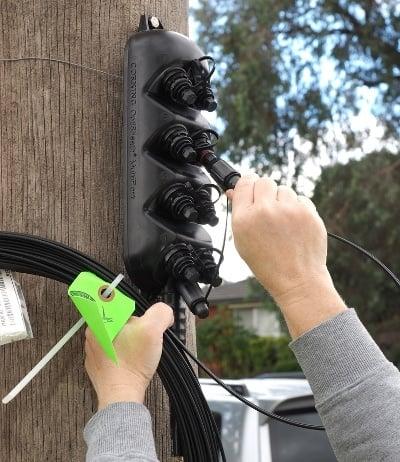Why PON Optical Interfaces Use SC Connectors Instead of LC
Short summary: PON systems consistently use SC connectors rather than LC due to their single-fiber bidirectional architecture, cost efficiency, and simplified deployment for mass-market access networks.
The Industry Standard Observation
If you examine any PON (Passive Optical Network) product specifications, whether EPON, GPON, or 10G-PON, you’ll notice a consistent design choice: all optical interfaces use SC connectors, not the more compact LC connectors. This isn’t a coincidence but a deliberate engineering decision that reflects the fundamental architecture of PON systems.
Understanding SC vs LC Connectors
Before diving into PON-specific considerations, let’s clarify the differences between these two common connector types:
| Feature | SC Connector | LC Connector |
|---|---|---|
| Size | Large square housingCompact | small form factor |
| Cost | Lower cost | Higher cost |
| Applications | Single-fiber connections | Duplex pairs, high-density |
| Performance | High signal precision | Good signal precision |
SC connectors feature a robust square-shaped housing that’s generally more cost-effective and provides excellent signal quality with lower sensitivity to return loss. LC connectors, while smaller and enabling higher density connections, are typically used in pairs for separate transmit and receive channels.
The Core Reason: Single-Fiber Bidirectional Architecture
The primary reason PON systems use SC connectors lies in their fundamental single-fiber bidirectional transmission architecture. In PON networks, both upstream and downstream data travel over the same strand of optical fiber using different wavelengths:
- Downstream (OLT to ONU): 1490nm wavelength
- Upstream (ONU to OLT): 1310nm wavelength
This wavelength-division multiplexing (WDM) approach means that each PON port—whether on the OLT (Optical Line Terminal) or ONU (Optical Network Unit)—requires only one fiber connection for full duplex communication. The single-port SC connector is perfectly suited for this application.
Additionally, the lower cost of SC connectors aligns perfectly with access networks, where millions of connections are deployed. This cost efficiency helps reduce the overall network deployment expense.
Why Not Dual-Fiber Architecture with LC?
To appreciate the elegance of single-fiber PON, consider the alternative: a dual-fiber bidirectional system using LC connectors. This approach would require separate transmit and receive fibers, effectively doubling the infrastructure requirements:
- 2x Fiber Usage: Every connection would need two fibers instead of one
- 2x Splitter Count: Double the number of optical splitters throughout the ODN
- 2x Space Requirements: Fiber distribution frames and enclosures would need double the capacity
- 2x Material Costs: The entire ODN (Optical Distribution Network) cost would approximately double
For last-mile access networks serving millions of subscribers, such cost multiplication would make FTTH deployment economically unfeasible.
Operational Advantages of Single-Fiber Design
Beyond cost savings, single-fiber PON architecture offers significant operational benefits:
Elimination of Cross-Connection Issues
In dual-fiber systems, proper fiber polarity is critical—transmit ports must connect to receive ports. Incorrect connections (often called “crossed fibers” or “polarity mismatches”) can cause complete communication failure. This complexity increases installation time and troubleshooting difficulty.
Single-fiber architecture eliminates this issue entirely, as both directions share the same fiber path.
Simplified Network Management
With fewer fibers to manage, network operators benefit from:
- Reduced documentation complexity
- Simpler fault isolation and testing
- Lower maintenance overhead
- Easier capacity planning and upgrades
Technical Advantages of PON Single-Fiber Design
The single-fiber bidirectional approach maximizes the efficiency of fiber optic bandwidth resources. By transmitting both upstream and downstream signals on different wavelengths over the same fiber, PON networks achieve:
- Optimal Bandwidth Utilization: Full duplex communication over single fiber
- Reduced Infrastructure Footprint: Minimal space requirements in cable ducts and distribution frames
- Lower Environmental Impact: Less material consumption for network deployment
- Faster Deployment: Fewer connections to make and test during installation
Real-World Implementation Considerations
The SC connector choice for PON interfaces reflects practical deployment realities:
Manufacturing Economics
For mass-produced PON equipment, the cost difference between SC and LC connectors becomes significant when multiplied across millions of ports. SC connectors’ simpler design and lower material cost make them ideal for high-volume access network equipment.
Field Service Advantages
SC connectors’ push-pull mechanism is more forgiving in field conditions compared to LC connectors’ latch design. This robustness is valuable for installations in varied environments—from climate-controlled equipment rooms to outdoor cabinets.
Standardization Benefits
The widespread adoption of SC connectors in PON equipment creates a unified ecosystem, reducing the need for adapter cables and simplifying inventory management for service providers.
Conclusion: Design Excellence Through Simplicity
The choice of SC connectors for PON optical interfaces demonstrates thoughtful engineering that prioritizes cost efficiency, operational simplicity, and scalability. This design decision, combined with single-fiber bidirectional transmission, creates a network architecture that:
- Minimizes deployment and operational costs
- Reduces installation complexity and potential errors
- Provides a scalable foundation for growing bandwidth demands
- Enables economically viable mass-market fiber deployments
These advantages help explain why PON has become the dominant technology for FTTH and other access network applications worldwide.
Need PON-Compatible Fiber Solutions? Contact ZTO Cable for comprehensive PON network components including drop cables, splitters, and connectors optimized for cost-effective access network deployment.

